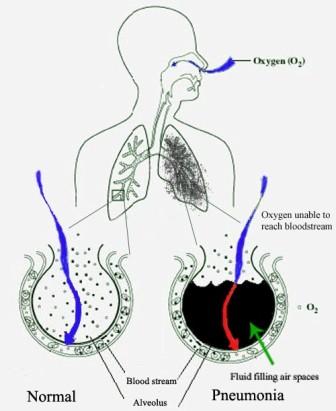Pneumonia history and symptoms
|
Pneumonia Microchapters |
|
Diagnosis |
|---|
|
Treatment |
|
Case Studies |
|
Pneumonia history and symptoms On the Web |
|
American Roentgen Ray Society Images of Pneumonia history and symptoms |
|
Risk calculators and risk factors for Pneumonia history and symptoms |
Editor-In-Chief: C. Michael Gibson, M.S., M.D. [1]; Associate Editor(s)-in-Chief: Hamid Qazi, MD, BSc [2], Priyamvada Singh, M.D. [3]
Overview
People with pneumonia often have a productive cough, fever, chills, shortness of breath, pleuritic chest pain, hemoptysis, headaches, diaphoresis, and clammy skin. Other possible symptoms are loss of appetite, fatigue, cyanosis, nausea, vomiting, mood swings, and joint pains or muscle aches. In elderly people manifestations of pneumonia may not be typical. They may develop a new or worsening confusion or may experience unsteadiness, leading to falls. Infants with pneumonia may have many of the symptoms previously mentioned, but in many cases they are lethargic or have a decreased appetite.
History and Symptoms
 |
Common Symptoms [1][2][3][4]
- Dyspnea
- Productive cough (greenish or yellow sputum). If a cough persists for 2 eeks or more, consider chlamydia pneumoniae, mycoplasma pneumoniae, or bordetella pertussis.
- Fever (high grade) with sweating, chills, and rigor
- Pleuritic chest pain
- Rapid, shallow breathing
- Shortness of breath
Less Common Symptoms
Elderly
The manifestations of pneumonia might not be typical in older people. They may instead experience:
Infant
Atypical Pneumonia
Community Acquired Pneumonia
History
Important components in a patient's history when he/she is presenting with symptoms suggestive of pneumonia include:
- Duration of symptoms
- Fever pattern
- Productive or dry cough. If a cough persists for 2 eeks or more, consider chlamydia pneumoniae, mycoplasma pneumoniae, or bordetella pertussis.
- Characteristics of sputum
- Presence of chest pain
- Presence of hemoptysis
- Recent sick contacts
- Travel history
- Smoking history
- History of other pulmonary conditions
- Recent hospital/health-care facility admission
- Antibiotic use
Symptoms
Common Symptoms
- The common features of community acquired pneumonia are:
- Fever
- Cough
- Chest pain mainly pleuritic type
- Dyspnea
- Sputum production
- Sputum color may help in detecting the causative agent of the pneumonia.
- Mucopurulent is a typical feature suggesting bacterial etiology
- Watery or clear fluid points out towards atypical bacteria and virus.
- Rusty colored sputum is more typical of pneumococcal pneumonia.
- Rapid, shallow breathing
Atypical or uncommon symptoms
- The other atypical or less common features of pneumonia are:[5]
- Fever with chills or rigors
- Other system may also be involved like gastrointestinal which present with nausea, vomiting and diarrhea.
- If pneumonia is very severe the patient may also have altered consciousness.
Elderly
The manifestations of pneumonia, like those for many conditions, might not be typical in older people. They may instead experience:
- Confusion[6]
- Delirium
- Falls
- Hypothermia
Infant
Hospital Acquired Pneumonia
Common Symptoms
- Dyspnea
- Productive cough (greenish or yellow sputum)
- Fever (high grade) with sweating, chills, and rigor
- Pleuritic chest pain
- Rapid, shallow breathing
Less Common Symptoms
Elderly
The manifestations of pneumonia, like those for many conditions, might not be typical in older people. They might instead experience:
- Delirium
- Hypothermia
- Falls
Infant
Atypical Pneumonia
References
- ↑ Musher, Daniel M.; Thorner, Anna R. (2014). "Community-Acquired Pneumonia". New England Journal of Medicine. 371 (17): 1619–1628. doi:10.1056/NEJMra1312885. ISSN 0028-4793.
- ↑ "WHO Pneumonia Fact Sheets".
- ↑ Mandell, L. A.; Wunderink, R. G.; Anzueto, A.; Bartlett, J. G.; Campbell, G. D.; Dean, N. C.; Dowell, S. F.; File, T. M.; Musher, D. M.; Niederman, M. S.; Torres, A.; Whitney, C. G. (2007). "Infectious Diseases Society of America/American Thoracic Society Consensus Guidelines on the Management of Community-Acquired Pneumonia in Adults". Clinical Infectious Diseases. 44 (Supplement 2): S27–S72. doi:10.1086/511159. ISSN 1058-4838.
- ↑ "National Institute of Allergy and Infectious Diseases - Pneumococcal Pneumonia".
- ↑ Marrie, TJ. (1994). "Community-acquired pneumonia". Clin Infect Dis. 18 (4): 501–13, quiz 514-5. PMID 8038304. Unknown parameter
|month=ignored (help) - ↑ Waterer, GW.; Kessler, LA.; Wunderink, RG. (2006). "Delayed administration of antibiotics and atypical presentation in community-acquired pneumonia". Chest. 130 (1): 11–5. doi:10.1378/chest.130.1.11. PMID 16840376. Unknown parameter
|month=ignored (help)